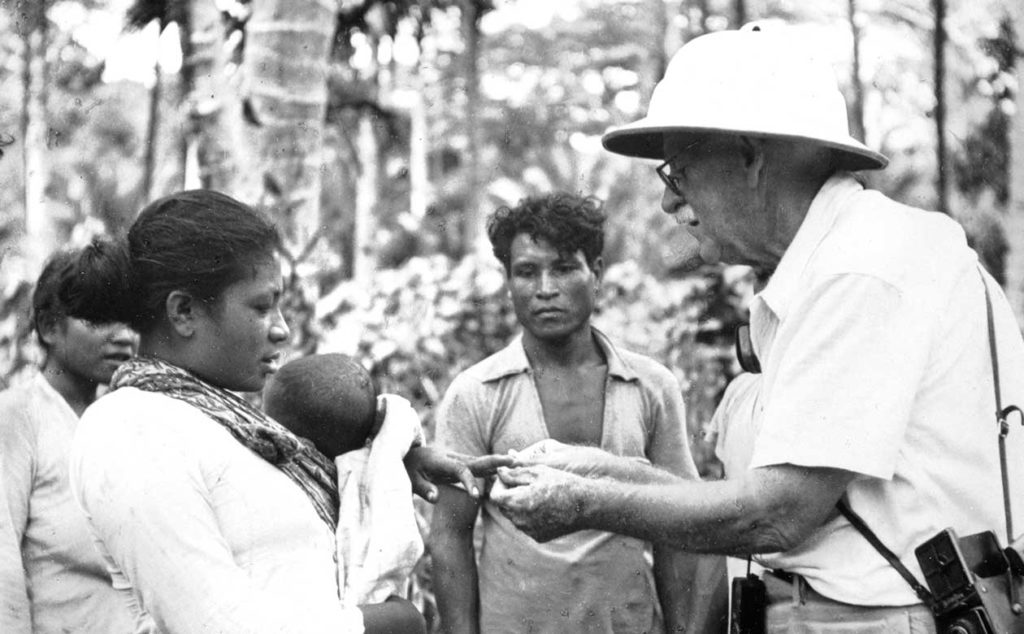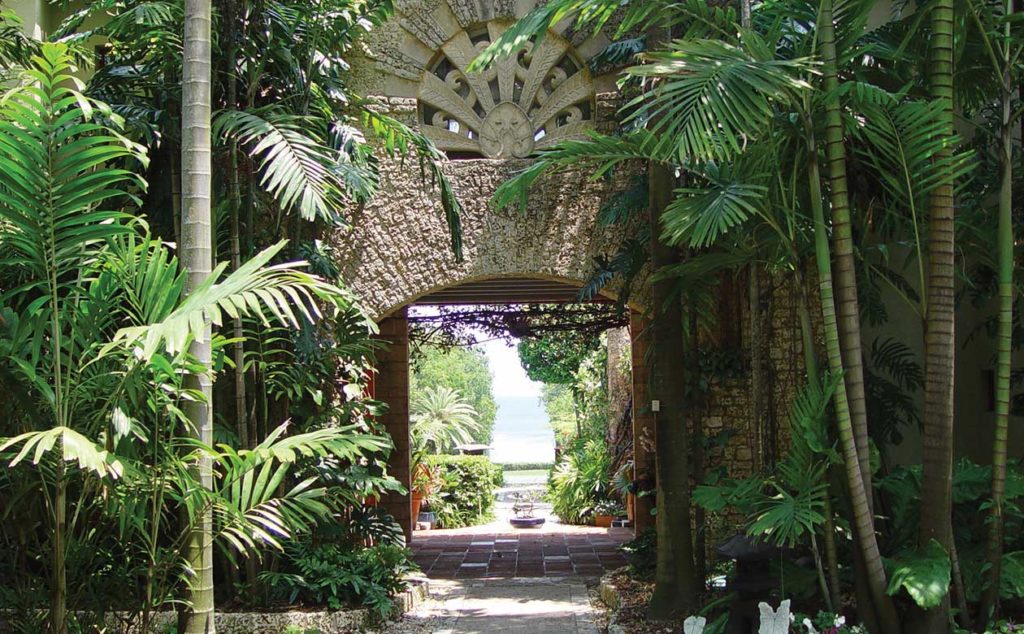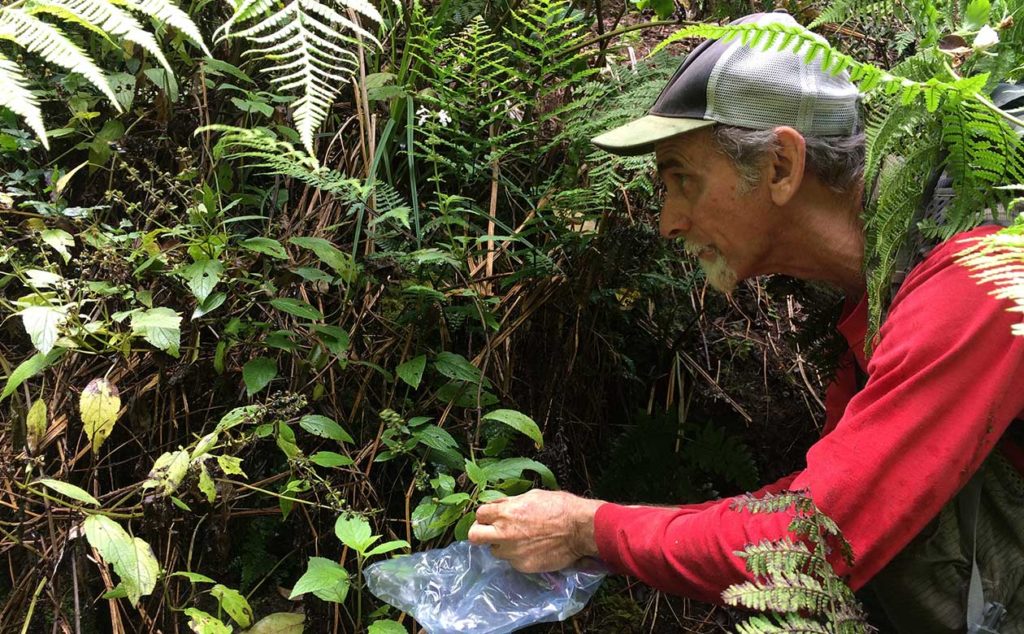To protect the food of the future, humans must learn from the past. A secluded garden in Florida preserves a 19th-century culinary curator’s tall tales and botanical introductions, while modern-day NTBG plant hunters in Hawaii use advanced technology to document and save species in biodiversity hotspots. With your help, NTBG is stemming the tide of plant loss and food insecurity. When you donate to the National Tropical Botanical Garden, you’re a part of this critical work that keeps our plants and our planet healthy.
It’s hard to imagine in today’s social media-induced foodie frenzy that the American diet has been anything other than a cultural melting pot of culinary curiosities. However, as Author Daniel Stone writes in his 2018 novel, The Food Explorer: The True Adventures of the Globe Trotting Botanist Who Transformed What America Eats, the same way immigrants came to our shores, so too did our food.
Before the 20th century, much of what America ate was meat, seafood, leafy greens, beans, grains, and squash – nutritious and hearty, but hardly the colorful, flavorful fruits and vegetables easily acquired from grocery store shelves and farmers markets today. Surprisingly, we have one adventurous, botanizing plant hunter to thank for most of the introduced tropical fruit, nuts, and grains that have become prominent parts of the American diet, and he is closely connected to NTBG.

David Fairchild was one of the world’s leading plant collectors in the early 20th century. His private residence in Coconut Grove, Florida, is the present-day location of NTBG’s Kampong Garden. With heritage collections of numerous Southeast Asian, Central, and South American fruits, palms, and flowering trees, The Kampong protects Fairchild’s horticultural legacy and many of his original introductions to the US. It also provides a window into the past that inspires today’s plant hunters and food protectors working toward a more resilient future for our plants and planet.
“The greatest service which can be rendered any country is to add a useful plant to its culture.”
Thomas Jefferson
David Fairchild was born in the late 19th century and grew up in reconstruction-era America. At that time farmers made up most of the country’s workforce and economic opportunity outside of agriculture was sparse. With a fragile post-war economy largely dependent on farming, The United States Department of Agriculture (USDA) feared that an invasive species or natural disaster could easily disrupt the nation’s food supply and created a plant pathology division aimed at diversifying the nation’s agricultural offerings.
Fairchild joined the division after receiving his education in horticulture and botany from Kansas College, and traveled the world as part government food spy, part horticulturalist, part adventurer seeking new food and crops for the expanding American economy and diet. After several years of botanical escapades across Europe, Southeast Asia, Central and South America, he became the chief plant collector for the USDA and led the Department of Seed and Plant Introductions vastly increasing the biodiversity of the nation’s food crops.
Chances are, at least one of the beverages or meals you consumed today would not have been possible without Fairchild’s introductions. Avocado, mango, kale, quinoa, dates, hops, pistachios, nectarines, pomegranates, myriad citrus, Egyptian cotton, soybeans, and bamboo are just a few of the thousands, if not hundreds of thousands of plants Fairchild introduced to the United States.

“Fairchild was key to the development of agricultural research and introduction stations around the US and in Puerto Rico. Many of those stations are still current and viable, acting as gene banks for plants he brought into the country,” said Craig Morell, Director of The Kampong. “The Kampong houses some of his early introductions, but these were mostly plants he liked to have in his personal garden. We maintain them today in the same fashion that museums curate and preserve antiquities,” Morell continued.
“Fairchild was key to the development of agricultural research and introduction stations around the US and in Puerto Rico.”
Craig Morell, Director of The Kampong
Fairchild’s work fundamentally changed the American diet and agricultural economy, and his career as a plant hunter, gene banker, and horticulturalist continues to inspire those following in his footsteps today.
Hawaii was selected for NTBG’s headquarters because of its status as a biodiversity hotspot. This means that while rich in biodiversity, Hawaii’s flora and fauna are deeply threatened by climate change, invasive species, and human activity. While the rate of species loss continues to accelerate worldwide, 2020 was a banner year for NTBG’s modern-day plant hunters. Our team of scientists discovered previously unknown populations of nine rare and endangered species including, Hibiscadelphus distans; Melicope stonei; Schiedea viscosa; Lysimachia scopulensis; Lepidium orbiculare; and Isodendrion laurifolium. Bolstering biodiversity hotspots not only strengthens our food supply, it also builds resilience and ensures ecosystems continue to sustain life, supply oxygen, clean air and water.

“These discoveries offer new hope for conservation of Hawaii’s endangered rare plants and native forests,” said Nina Rønsted, NTBG Director of Science and Conservation. “These findings also illustrate the importance of investing in science as a vital tool to better understand and protect the natural world,” she continued.
Like Fairchild, today’s plant hunters are no strangers to thrill and adventure. NTBG botanists have long been known for repelling down sheer cliffs and into steep valleys searching for rare plant life. Today, with the help of drone and mapping technology, NTBG remains at the forefront of tropical plant discovery and conservation.
“Hawaii has been referred to as the extinction capital of the United States,” said Ben Nyberg, NTBG GIS specialist and drone pilot. “It’s home to 45% of the country’s endangered plant population, and we don’t know how climate change and new threats like Rapid Ohia Death will affect these rare plants’ habitats. We are trying to document and collect material as quickly as possible,” he finished.
“These discoveries offer new hope for conservation of Hawaii’s endangered rare plants and native forests.”
Nina Rønsted, NTBG Director of Science and Conservation
NTBG sets itself apart in the race to save rare and endangered tropical plants. In addition to collecting, categorizing, and seed banking rare plant material, NTBG outplants thousands of rare and endemic species into our gardens and preserves located across the Hawaiian Islands.
From now through 2022, NTBG will engage in a conservation project called, Securing the Survival of the Endangered Endemic Trees of Kauai supported by Fondation Franklinia. This project will focus on eleven species that either previously grew in the Limahuli Valley or have a remnant population of fewer than ten individuals. Throughout the three-year project, NTBG will collect and propagate seeds and use previous collections from our seed bank to balance the need for substantial seed collection. When the new treelets are strong enough, most will be outplanted in the Limahuli Preserve to monitor and protect them. Alongside the Fondation Franklinia project and with the help of our supporters and collaborators, NTBG remains dedicated to saving as many endangered plant species as possible as we work to protect and restore native ecosystems on Kaua‘i and beyond.
From the outlandish adventures and introductions of a 20th-century plant hunter to modern-day scientists using drones to seek out rare plant life on the steep cliffs and rocky ridges of Kauai, NTBG is learning from the past and leading the way in the fight to protect the future of food, plants, animals, and ecosystems. Learn more and support plant-saving science today.
NTBG is a nonprofit organization dedicated to saving and studying tropical plants. With five gardens, preserves and research centers based in biodiversity hotspots in Hawaii and Florida, NTBG cares for and protects the largest assemblage of Hawaiian plants. Join the fight to save endangered plant species and preserve plant diversity today by supporting the Healthy Plants, Healthy Planet campaign.